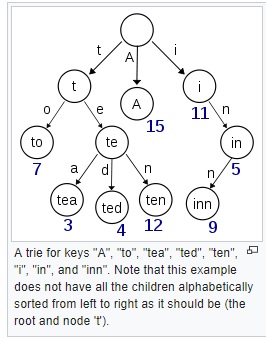Implement a trie with insert, search, and startsWith methods.
Example:
Trie trie = new Trie(); trie.insert("apple"); trie.search("apple"); // returns true trie.search("app"); // returns false trie.startsWith("app"); // returns true trie.insert("app"); trie.search("app"); // returns trueNote:
You may assume that all inputs are consist of lowercase letters a-z.
All inputs are guaranteed to be non-empty strings.Your Trie object will be instantiated and called as such:
Implement a Trie in Python
The Trie is a useful data structure that can be used to store words so that we can check if any given word (or prefix) is in the list in linear time O(N).
It is simple to implement a Trie class in Python. For each Trie Node, we need to tell if is a leaf node (indicates a word), and the children nodes. Then we start from the begining of the word, follow the path in the Trie tree, until the end, or the corresponding child is not existent in the Trie.
The startsWith, search and insert are of similar implementations with slight difference.
1 2 3 4 5 6 7 8 9 10 11 12 13 14 15 16 17 18 19 20 21 22 23 24 25 26 27 28 29 30 31 32 33 34 35 36 37 38 39 40 41 42 43 44 45 46 47 48 49 50 | class Trie(object): def __init__(self): """ Initialize your data structure here. """ self.nodes = {} self.leaf = False def insert(self, word): """ Inserts a word into the trie. :type word: str :rtype: None """ root = self for i in word: if i in root.nodes: root = root.nodes[i] else: root.nodes[i] = Trie() root = root.nodes[i] root.leaf = True def search(self, word): """ Returns if the word is in the trie. :type word: str :rtype: bool """ root = self for i in word: if i in root.nodes: root = root.nodes[i] else: return False return root.leaf def startsWith(self, prefix): """ Returns if there is any word in the trie that starts with the given prefix. :type prefix: str :rtype: bool """ root = self for i in prefix: if i in root.nodes: root = root.nodes[i] else: return False return True |
class Trie(object):
def __init__(self):
"""
Initialize your data structure here.
"""
self.nodes = {}
self.leaf = False
def insert(self, word):
"""
Inserts a word into the trie.
:type word: str
:rtype: None
"""
root = self
for i in word:
if i in root.nodes:
root = root.nodes[i]
else:
root.nodes[i] = Trie()
root = root.nodes[i]
root.leaf = True
def search(self, word):
"""
Returns if the word is in the trie.
:type word: str
:rtype: bool
"""
root = self
for i in word:
if i in root.nodes:
root = root.nodes[i]
else:
return False
return root.leaf
def startsWith(self, prefix):
"""
Returns if there is any word in the trie that starts with the given prefix.
:type prefix: str
:rtype: bool
"""
root = self
for i in prefix:
if i in root.nodes:
root = root.nodes[i]
else:
return False
return True The space requirement for Trie is O(NM) where N is the number of words, and M is the average length of each word. The runtime complexity for searching a word in the Trie is O(M).
Trie Algorithms Implementations:
- Teaching Kids Programming – Python Implementation of Trie Data Structure (Prefix Tree)
- C++ Implementation of Trie Data Structure using Hash Map
- The Beginners’ Guide to Trie: How to Use the Trie in C++?
- Trie Class Data Structure in Python
- GoLang: Implement Trie (Prefix Tree)
–EOF (The Ultimate Computing & Technology Blog) —
loading...
Last Post: How to Monitor the CPU Temperature of Raspberry PI using Python Script?
Next Post: The Best Instagram Feed WordPress Plugins to Use
